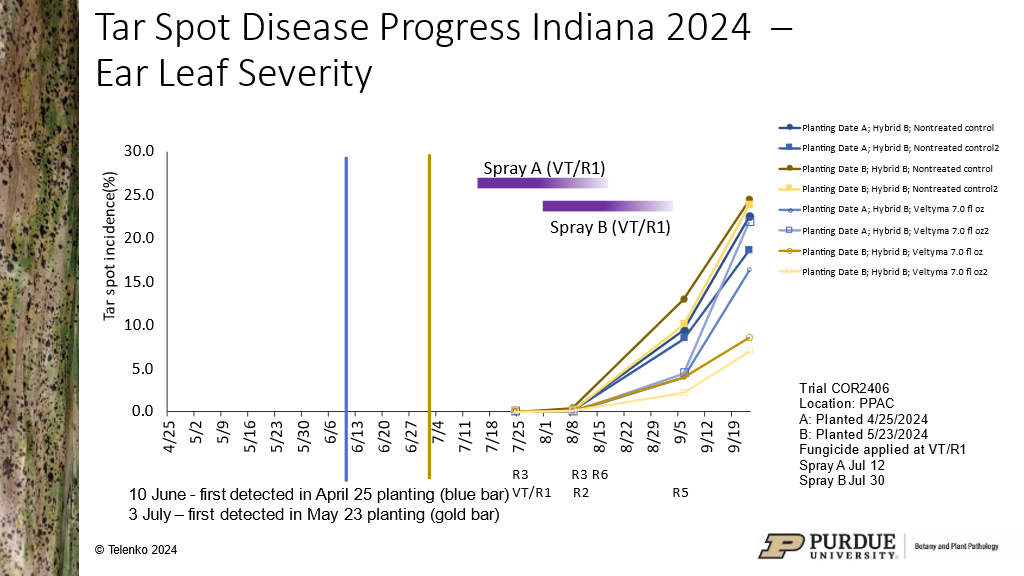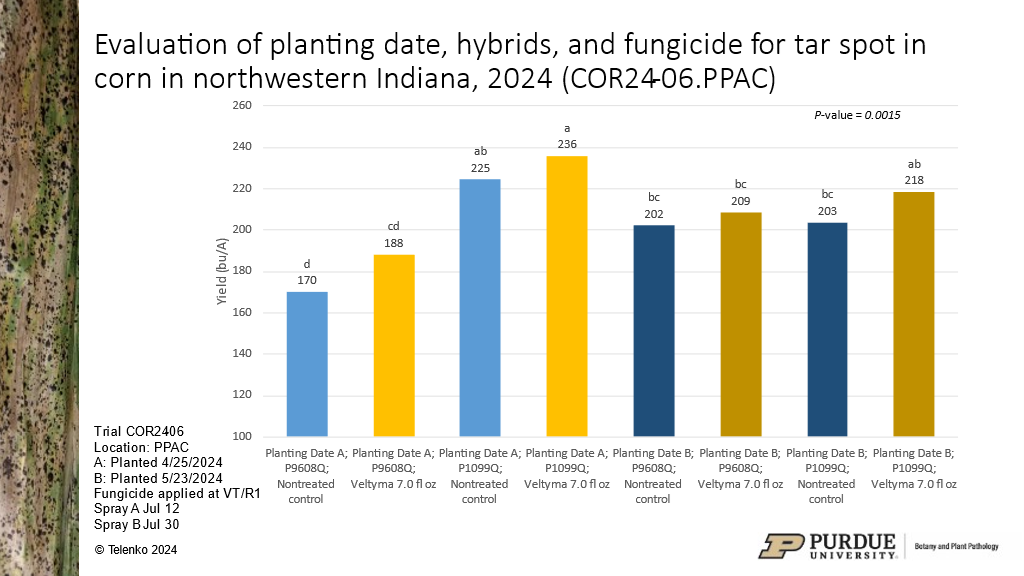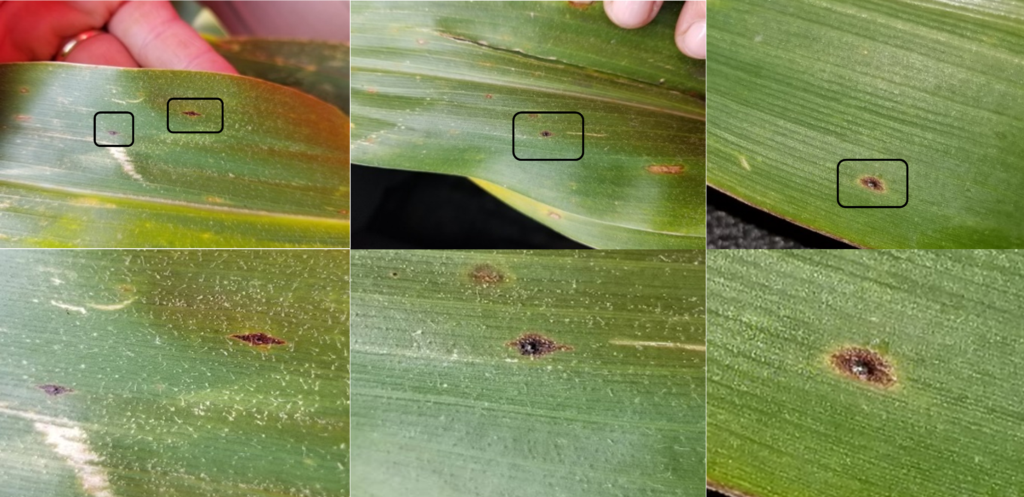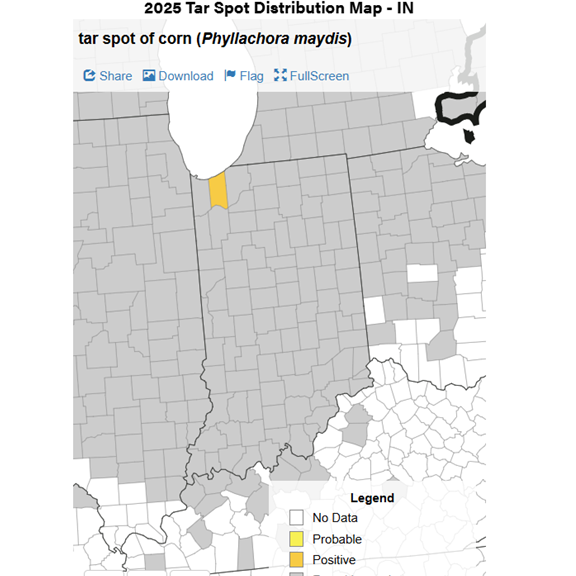Tar spot confirmed in our research plots in Indiana this week.
Corn growth stages are quite variable across Indiana, but a number of areas with early planted corn are about knee high. I just scouted our research plots in northern Indiana at the Pinney Purdue Ag Center (Porter County) and have found the primary infections of tar spot in our first planting of corn (planted April 28), the corn ranged from V3-V5 (Figure 1). This research site is continuous no-till corn and the same location where I found it last year on June 10, so finding it yesterday June 11 isn’t too different from last year.
Recent cool weather and rain have been very conducive conditions for tar spot to get started. I would say in the next couple of weeks keep an eye out and scout that lower canopy. As a reminder for disease to occur, three things need to be present 1. Pathogen, 2. Host, and 3. Favorable Environment.

A few questions to think about when scouting and looking for disease:
1. What is the disease history in the field? How much residue is still present? (What happened in previous years?)
2. What growth stage is the field? Early planting vs. late
3. Is irrigation being applied? How much and how often? If water is being applied, it can change the environmental conditions and disease risk in a field.
At the research site where we found tar spot disease incidence was less than 1% in the plots (number of plants with tar spot), which is still really low. Last year when we found tar spot on June 10 our average incidence was 3-4% (Figure 2). After that first find last year, we started to see the secondary infections about June 27 and from that point on continued to see the disease increase in the crop canopy. Tar spot didn’t reach the ear leaf in this trial until July 25 (Figure 3). In this trial a fungicide spray was applied at tassel/silk (VT/R1) growth stage at each planting date (July 12 and July 30). The VT/R1 fungicide application timing significantly reduced tar spot at the ear leaf through September 6 (dent R5 growth stage). Figure 4 shows the resulting yield from this trial. You can see that the fungicide application (gold bars) significantly increased yield in the first planting date, and provided greater yield protection, whereas the yield protection at the later planting date was not significantly different from nontreated. In general, from this single trial in northern Indiana in 2024, a fungicide application at VT/R1 provided 7-18 bu/A yield protection when compared to corresponding nontreated. More details on this research trial can be found on page 27 in our annual research publication Applied Research on Field Crop Disease 2024. Purdue Extension. PP-2024. (https://indianafieldcroppathology.com/wp-content/uploads/2025/03/BP-Extension-Applied-Research-on-Field-Crop-Disease-2024.pdf)



Tar spot continues to be a concern this season. Tar spot may be hard to find early Figure 5 shows examples on how small the initial tar spot lesions (stromata) will be. I am not as worried about finding these first tar spots in the first few leaves of the corn, what I’m really interested in to make an informed decision on putting a fungicide out, is what are you finding once corn is V8-V10? At that point I usually find the tar spot (stromata) in fully-expanded leaves knee to hip height in the canopy and this what we are really looking to find. We will continue to monitor for disease and keep you updated. Again, the recent favorable weather has helped to promote tar spot.
I would like to make a few recommendations.
If you have a history of the tar spot it is time to keep an eye out and make an informed management decision.
Once corn has reached V10 then look at the new Crop Rick Tool (https://cropprotectionnetwork.org/crop-disease-forecasting) to see if environmental risk is high in your field. This tool replaces the Tarspotter App.
What to look for when scouting: Small, black, raised spots (circular or oval) develop on infected plants, and may appear on one or both sides of the leaves, leaf sheaths, and husks. Spots may be found on both healthy (green) and dying (brown) tissue.
You can use the Crop Risk Tool initially to tell you to get out and scout (but right now the whole state of Indiana has been high risk) – we have time to apply fungicides if we find tar spot in the lower canopy. We don’t want to apply fungicides before growth stages of V10.
Research has shown the best return on investment in making a fungicide application in corn occurs when the fungal diseases are active in the corn canopy between VT to R3. You just need to be scouting for those early lesions to help inform your decision making.
But, don’t wait too long, if significant disease develops in the upper canopy, then a fungicide application may be too late at that time.

When should I be putting out a fungicide?
A well-timed, informed fungicide application will be important to reduced disease severity when it is needed, and we recommend holding off until the diseases is active in your field and corn is at least nearing tassel/silk (VT/R1) or even blister (R2). Scouting will be especially important if the recent rains we have seen continue.
We are working hard to try to understand this new disease to minimize losses. The good news is that there are a number of fungicides are highly efficacious against tar spot here in Indiana when applied from tassel (VT) to milk (R3). I would recommend picking a product with multiple modes of action. The national Corn Disease Working Group has developed a very useful fungicide efficacy table for corn diseases (see link).
https://cropprotectionnetwork.org/publications/fungicide-efficacy-for-control-of-corn-diseases
We will continue keeping a close eye on tar spot.

Please help us track tar spot and southern rust, contact me if you suspect a field has tar spot and/or send a sample to the Purdue PPDL for confirmation. Checkoff funding from the Indiana Corn Marketing Council is supporting sample processing, therefore there will be no charge for corn tar spot or southern rust samples submitted to the clinic.
I want to ask before you submit a sample you do a quick and dirty “scratch test” to see if you can rub the spot off the leaf, especially if you have leaves with just a few small spots. I have been successful in detecting these false spots by using my nail to scratch as the suspect lesion. This is a quick way to check, but as always if you are unsure send an image or the sample to the Purdue Plant Pest Diagnostic Lab. Please collect several leaves showing the symptoms and send them with a PPDL form https://ag.purdue.edu/department/btny/ppdl/submit-samples/_docs/ppdl-1-w.pdf
Please wrap the leaves in newspaper, ship in a large envelope, and ship early in the week. If you are sending samples from multiple locations, please label them and provide the date collected, hybrid if known, field zip code or county, and previous crop (see article on Field Crop Disease Samples Needed in Indiana).
Mail to: Plant and Pest Diagnostic Laboratory, LSPS-Room 116, Purdue University, 915 W. State Street, West Lafayette, Indiana 47907-2054. The lab is operating and the building is open. If dropping off a sample is more convenient than shipping, please call or email the lab prior to stopping by Phone – 765-494-7071 or Email – ppdl-samples@purdue.edu.
In addition, the 2025 tar spot and southern rust maps are live that will be updated when a positive county confirmation is detected. If you are interested in up-to-date information on the current detection of these diseases, the maps are available on the front page of our Extension website https://indianafieldcroppathology.com/
If you have any question please contact Darcy Telenko (dtelenko@purdue.edu/764-496-5168) or PPDL (ppdl-samples@purdue.edu/765-494-7071)
